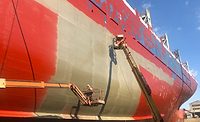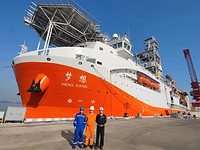Protecting Vessel and Ocean Health
Requires a Careful Balancing Act




During a 2020 study conducted by biotechnology company I-Tech AB, and independent marine coatings consultant Safinah Group, data indicated that nearly every vessel examined and analyzed posed a significant biosecurity threat to our oceans’ health and shipping’s environmental impact.
While hard fouling accounts for detrimental levels of fuel consumption, biofouling in ‘niche’ areas — such as sea chests, thrusters and gratings — presents some of the most notable and widespread risks from a biosecurity perspective.
In shipping’s ongoing efforts to survive and thrive in the global economy, and on the backdrop of societal and regulatory pressure to reduce maritime’s impact on the environment, tackling biofouling head-on and mitigating the risks has never been so important.
Niche Areas: The Vital Unseen of Vessel Operations
Although the data is difficult to obtain, niche areas could account for as much as 10% of the total underwater hull surface of the global shipping fleet.1 While all aspects of a vessel must be protected against hard fouling and biofouling, the risk of excessive build-up in niche areas means that ‘mission critical’ equipment can significantly decline or even fail.
Take the sea chest region of a vessel, for example. Fouling build-up here can impact the operational functionality of the box coolers, a vessel’s water-cooling system. The complex structure of a box cooler — comprised of a U-tube bundle that is fitted in the sea chest on the side of a vessel, and inlet and outlet grids — can make them challenging to effectively coat and clean, and easy for biofouling organisms to reside. Fouling here, if significant enough, can impact the reduction of heat exchange and result in a vessel’s temperature not lowering sufficiently, or needing a greater energy resource to obtain the target temperature.
There are a few reasons as to why niche areas are a favorable environment for biofouling organism accumulation. Namely the above, the complexity of the design structure in these areas can make it extremely difficult, even dangerous, to execute the cleaning of niche areas. And if not coated well during the vessel’s build, coating and re-coating after this can be significantly less effective.
Damage to coatings is also a common contributor, given the propensity of niche areas to be more affected by turbulence than, for example, a smooth hull area of a vessel. This can cause degradation of paints and efficacy. Additionally, the nature of niche areas means that restricted water flow can limit the action of certain biocidal antifouling coatings that require a sufficient flow.
Consequently, we cannot ignore these parts of the hull's submerged structure when it comes to biofouling. However, some signs suggest the global shipping community is doing just that.
Assessing the Problem
The issue of niche area fouling certainly isn’t a small one, nor one that can or should be ignored. A significant proportion of this threat comes not from hard fouling on flat underwater surfaces, but these niche areas spread throughout a vessel’s submerged structure.
The study found that while vessels’ flat underwater hull surfaces vary in their hard fouling coverage, at least 95% of the global commercial fleet has heavily fouled niche areas. And while this is an issue across all vessel types and purposes, the issue is significantly worse on ships travelling at a lower speed. 45% of lower-activity vessels surveyed were found to have suffered from hard fouling coverage of > 10%. This is compared to merely 27% of higher-activity vessels. This is an especially poignant point for vessels with typically slower speeds, enabling for higher volumes of biofouling and hard fouling, partially due to ease of attachment. Smaller vessel types also operate with greater standstill and downtime when, for example, passengers are embarking or disembarking.
The irony here is that these vessel types are the most likely to operate on some form of fuel technology that supports emissions reductions. For example, a dual-fueled engine, a hybrid electric or even fully electric. For the minimized impact these vessels may have on shipping’s carbon emissions — compared to other, larger vessels using heavy oil fuels — they can still cause detrimental effects to the environment and ecosystem through the fouling of niche areas.
Hull biofouling poses a serious biosecurity threat to marine ecosystems through its role in transporting invasive aquatic species (IAS). According to the International Maritime Organization (IMO), vessel biofouling has been a comparable, if not more significant, factor than untreated ballast water for the transportation of IAS. In fact, in some parts of the world, evidence suggests that 70-80% of invasive species introductions have occurred through biofouling.
Without decades of research, analysis and varying conditions by which to assess the severity of IAS, it is difficult to go into any meaningful detail about the long-term effects of the issue. However, one useful example might include the impact of the zebra and quagga mussels’ introduction in the United States, which alone was estimated to have caused some US$1 billion a year in damages and associated control costs.
Given the risks that this presents, and the difficulty of tackling niche areas, it is surprising that this is not a more widely recognized issue in the industry. Evidence suggests that may soon change.
Can Increasing Regulation Help Solve the Problem?
Regardless of the particulars, widespread legislation is on the horizon to protect our waters from the biosecurity risks biofouling presents. Indeed, we are seeing an increasing number of regions devise new requirements for vessels arriving and docking at port, particularly regions that already possess a number of inland regulations.
In recent years, authorities in New Zealand have taken a more stringent approach to preserving their delicate marine ecosystems. In 2017, the 33,752 dwt Korean-owned bulk carrier DL Marigold was forced to leave New Zealand waters after its hull was deemed a biosecurity threat, with dense barnacles and tube worm coverage on its underwater surfaces. Under new biosecurity rules that entered into force in May 2018, all international vessels arriving into New Zealand must now have a clean hull.
Similarly, Californian port restrictions — as of October 2017 — state that all vessels of 300 gt or more must complete and submit a Marine Invasive Species Program Annual Vessel Reporting Form at least 24 hours before their first arrival of the calendar year at any Californian port. In addition, as of January 2018, ships must present a ‘Biofouling Management Plan’ and record all management actions in a record book.
The challenge here, for many, is seeing past the red tape. These regulations may very well be the beginnings of stricter measures being put in place around vessel requirements when entering coastal waters, and greater emphasis on hull safety.
With the potential for increased regulation comes the vital need to develop and deploy effective antifouling agents, the substance added to coatings to tackle biofouling. Yet a fresh challenge presents itself here, as many of these active agents, and other tools used to mitigate fouling, are facing growing restrictions in their use around the world. For coatings, this is predominantly because of what is known as the ‘biocidal load’ of an active agent.
The biocidal load is determined by the level of potentially harmful chemical substances used in the composite of an agent and can include significant levels of chemicals to deter or eradicate hard fouling and biofouling. Many biocides used in vessel coatings actively kill barnacles and other forms of fouling. This accelerates the pressure for the industry to develop environmentally and species-friendly systems that don’t harm ocean species, without sacrificing the protection of vessel operations, and indeed, profitability.
While these sensitivities and requirements may appear to be a challenge — potentially even a cause for great frustration — there are straightforward ways to mitigate the risk of biofouling in line with regulation, and they are not so complex as the issue at hand.
Finding a Solution
The first and most obvious step for operators and owners to take is effective use of antifouling coatings from the vessel’s development stage, which puts a ship in the best possible stead for future operations and ease of maintenance. Greater time and attention should be spent during this phase of a vessel’s lifecycle, in particular on the coating of niche areas where the structure can make application and ongoing maintenance extremely difficult.
And not all antifouling coatings are created equal. When considering which is best suited to a vessel's operations, a paint with a higher polishing rate will likely be much more effective for niche areas where low water flow conditions truly require an increased quality than the smooth areas of a vessel, in comparison.
Importantly, operators and owners should strive to be in full possession of all the facts when it comes to changes and various regulations. Regionally, regulation challenges can vary, but the European Union (EU) is at the forefront of strict marine environment regulatory action with stringent and escalating regulations around biocides. As member states must debate on how they approve products, the regulatory landscape here is particularly complex.
Selektope®, I-Tech’s active agent, has a seven-year approval from the EU, which is still ongoing, and is expected to pass its renewal in the early parts of 2023. The agent is an alternative form of biocide, largely because it repels barnacles and other forms of biofouling, rather than terminating; a significant benefit to its implementation and its ability to gain regulatory approval.
Selektope isn’t a typical biocide. In addition to it being a repellent, rather than a terminator of fouling species, the agent is so effective in small concentrations, it reduces the overall biocidal load of any coating to which it is added. A clear main advantage from a regulatory standpoint.
Conclusion
Like most challenges facing the shipping industry, biofouling will ultimately require not one but many solutions and supporting players to help protect vessel operations and the environment. As we are seeing amidst other sectors and issues, collaborative thinking and a unified mentality to find viable solutions will significantly accelerate maritime’s ability to tackle biofouling and its detrimental effects.
For more information, click here.
References
¹ Moser, C.S.; Wier, T.P.; First, M.R. et al. Quantifying the extent of niche areas in the global fleet of commercial ships: the potential for “super-hot spots” of biofouling. Biol Invasions 19, 1745-1759 (2017). https://doi.org/10.1007/s10530-017-1386-4.
Looking for a reprint of this article?
From high-res PDFs to custom plaques, order your copy today!






.png?height=200&t=1722533320&width=200)



